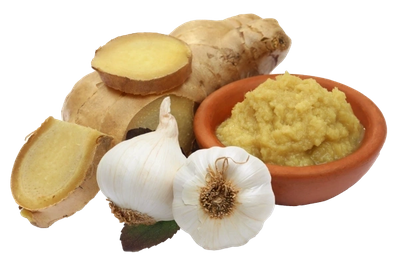
T for Traditional Medicinals
Born and raised in a small town in India, my mum always turned to, natural medicinals and herbalism because she believed that plants had the power to treat a variety of ailments.
Many of these powerful healing medicinals were generally found in her pantry! She often narrated stories about our grandparents and ancestors who used these remedies for thousands of years and how we continue to treat ourselves even today.
Here are some of her favorites remedies and how she taught me to use them. (Yes, I too am super fan of these now)
1: GARLIC
Garlic has powerful antibacterial, antifungal, and antiviral properties. Unlike conventional antibiotics, garlic may have the ability to fight different virus strains, thus having the potential to offer broader protection. Ancient modalities like Traditional Chinese Medicine and Ayurveda consider garlic a powerful treatment for colds, flus, chest infections, digestive disorders, and fungal infections, etc. Research has shown that garlic is effective in helping lower blood pressure and cholesterol and therefore reducing the overall risk for cardiovascular disease. Garlic has also been shown to have anticarcinogenic and antitumor effects. Allicin, the ingredient responsible for garlic’s medicinal properties, loses its potency upon heating; cooking, sautéing, and baking with garlic don’t provide the same health benefits as consuming it raw. Therefore,crush a few cloves over a leafy green salad, combine it with olive oil and lemon juice for an antioxidant-rich dressing, or blend it into a homemade hummus. Raw garlic is also available in capsule and oil form.
2.TURMERIC
Turmeric has been used in Ayurveda as a means to balance the doshas and support good digestion. Recently, it has become the topic of many research studies due to its significant benefits, including anti-inflammatory and neuroprotective benefits. Curcumin, one of the active compounds in turmeric, has been shown to reduce oxidative stress. Turmeric is also known for its anticancer and cardioprotective properties. The turmeric root is a vibrant orange color – its pigment is so strong, it can even stain your fingers if handled directly! My mum always started our day with her special tea (cannot thank her enough for building my strong habits and strong immune system) To make turmeric tea, peel the skin of the root, add ginger slices , few pepper corns and simmer for 10 minutes before straining and serving. Add a tsp of manuka honey and enjoy.
3: GINGER
Like turmeric, ginger is a common remedy in Ayurveda and known for its antiinflammatory, antimicrobial, and antitumor properties. Ginger is used to stimulate digestion and is also a popular remedy for nausea. Its main active compound is gingerol. Research has shown ginger to support blood glucose regulation, reduced risk of stomach ulcers, and decreased symptoms of osteoarthritis. Ginger root works well in both savory and sweet dishes. Grating a bit of ginger over salads, soups, curries, fruit, or stir-frys is not only a great way to add flavor but a great way to promote health!
4.COCONUT OIL
Coconut oil is a versatile health food and skin-care product. The oil is extracted from the meat of mature coconuts and harvested from the coconut palm. Coconut oil contains an abundance of lauric acid, which has antimicrobial properties. Coconut oil can also easily replace store-bought moisturizer, lotion, makeup remover, lip balm, and hair conditioner – which all often contain harmful chemicals and preservatives. Adding coconut oil to your diet may provide benefits, including a reduced risk of infection, improved cholesterol levels, and a reduced appetite, which can help support a healthy weight. Coconut oil is also a great source of medium-chain triglycerides, making it an easily digestible form of fat. Due to its high heat capacity, coconut oil can replace traditional cooking oils, such as olive oil or sunflower oil. It also lends a unique flavor to baked goods or as an ingredient in dressings, marinades, and spreads. Keep in mind, however, that coconut oil is rich in saturated fats and should be enjoyed in moderation.
5.LEMON
Lemon is a versatile citrus fruit that grows on a small evergreen tree native to Asia. The fruit is commonly used in herbal medicine because of its powerful antibacterial and astringent properties. Its high levels of vitamin C, antioxidants, and flavonoids provide immunity protection against colds, flus, and many other bacterial or viral infections. Lemon also acts as a digestive tonic; the citric and ascorbic acids can help balance the blood’s pH by alkalizing the body.
Incorporating lemon as an everyday medicinal is relatively easy – use either the juice or the rind from organic, fresh lemons or use lemon essential oil. To experience the cleansing aroma of the essential oil, simply add a few drops to textiles or linens around your home for a calming scent. Lemon balm can be used to help with the healing and disinfecting process after dental work or to soothe a sore throat. Drinking fresh-squeezed lemon juice is also a natural and refreshing way to alkalize and energize the body.
6.MANUKA HONEY
(This one is my addition to the list, though mum used traditional homemade honey bought from a small village)
Manuka honey is derived from the manuka tree found in New Zealand and parts of Australia, where manuka honey is classified and regulated as a “therapeutic good.”
Due to its strong anti-inflammatory and antimicrobial properties, it’s often used as a topical treatment to help reduce the healing time for wounds and burns. Manuka honey may also help reduce the proliferation of cancer cells. As a food product, it has a strong flavor that’s often characterized as earthy, bitter, and oily and can help boost the health profile of teas, smoothies, and soups. Despite its Australasian origin, manuka honey is available worldwide in most health food stores and supermarkets. To avoid inauthentic manuka honey products, be sure the brand you buy has a Unique Manuka Factor (UMF), which indicates the level of antibacterial potency. Choose one with an optimum level of 10+. Also note that honey should not be given to infants.
